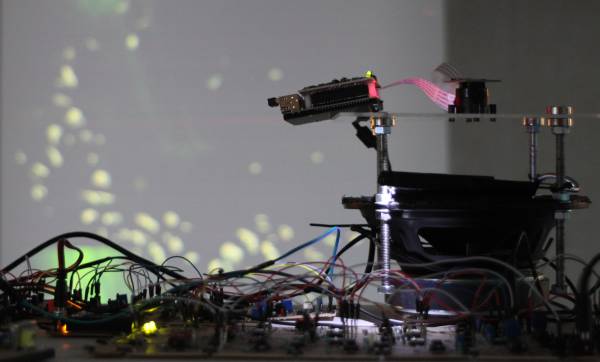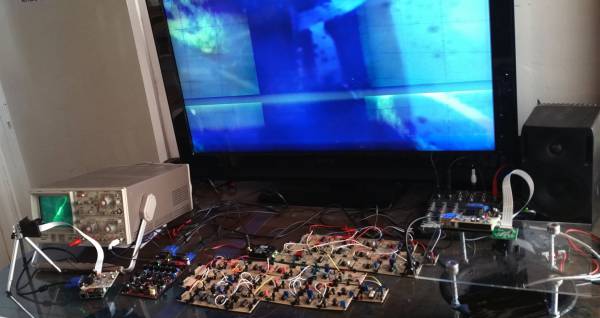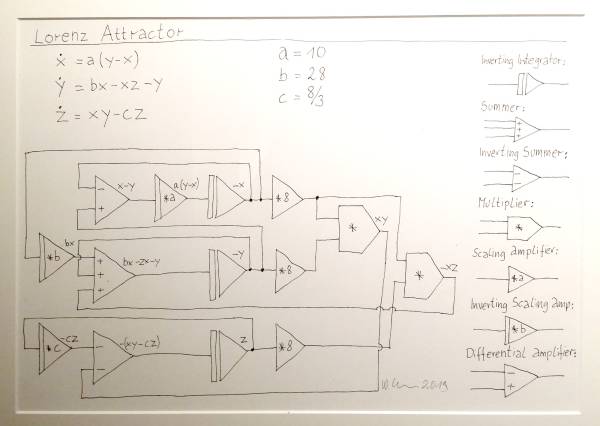Strange Attractors
a Lorenz System controlled by an other Lorenz System, 2019
Ever since the mathematician Benoit Mandelbrot geometrically described structures in nature as ‘self-similar systems’ in „How Long Is the Coast of Britain? Statistical Self-Similarity and Fractional Dimension“ a paper published in 1967, fractal structures have remained a subject of artistic enquiry. Strange attractors in their quality of chaotic fractals constitute together with self-similar structures an important part of chaos research, and feature as core and lead theme of the installation.
„Strange Attractors“ is about a generative system for sound and projections based on the analogue computer Confetti (developed by the artist) that calculates these Strange Attractors.
„Strange Attractors” rises the question if climate can be predicted, described by Julia Slingo, and Tim Palmer in Uncertainty in weather and climate prediction.
The title of the work refers to the mathematical term of the same name (David Ruelle / Floris Takens, 1971) borrowed from chaos theory which describes physical laws of chaotic behaviour in dynamic processes. Based on strange attractors it’s possible to for instance to mathematically describe turbulent currents of liquids or gases that cannot otherwise by analytically captured due to their complexity and level of randomness. In the installation two Lorenz Attractors are used to generate the sound as well as the visuals.
The work raised the question of the artistic definition of boundaries in a space which in fact is determined by coincidence. Strange attractors are defined among others by the fact that they always establish a limiting framework or an according order within which the actual chaos can take place. This means that – at least from a mathematical perspective – haphazardness and chaos are enabled by a framework that creates an order, because without this framework any conceivable chaotic system would rise ad infinitum, and by doing so would escape observation and description. If this thought were transferred to art, it would mean that artistically created chaotic systems would not be visible or audible. Accordingly, the installation raises the question whether the artists themselves create the framework that creates the order, allowing the work to emerge ‘haphazardly’.
The work was show in the exhibition “Self-Similar and Strange” at Art Claims Impulse in Berlin, 2019.
Acknowledgment
The work was inspiret by the article “Die Chaos-Maschine: Analoge Computer wiederentdecken”
Elector Magazine 09-10/2011 by Maarten H. P. Ambaum and
R. Giles Harrison (Department of Meteorology, University of Reading, UK).
Most knowledge about analog computers are from the Analog Museum.
The development of the Analog Computer Confetti was supported by Art Science BLR and the Indian Sonic Research Organization at the Srishti Institute of Art, Design and Technology, and the Goethe-Institut Max Mueller Bhavan.
Thanks to David Farris and TEREZA WATERS for helping with some mathematical problems.
Wolfgang Spahn is a visual & sound artist based in Berlin. His work includes installations, performances of light & sound and miniature-slide-paintings. His art explores the field of analogue and digital media and focuses on both their contradiction and their correlation.
He is faculty member of the Sound Studies and Sonic Arts, Berlin University of the Arts.
Katalog Kybersonor_2022_DE
Portfolio_Wolfgang Spahn DE
Portfolio_Wolfgang Spahn EN
GALLERY
OPEN HARD- & SOFT-WARE
Here is most of the hard- and software the artist developed for his artwork.
DER NULLEFFEKT
PAPER-PCB
- Analog Computer
- Pop Neuron
- Paper-Duino
- Paper Synthesizer
- Paper Bits
- Raspberry Pi Hats
- VGA Synthesizer
- Sound Boards
ART COOPERATION
TEACHING
Miscellaneous
Except where otherwise noted.
© 2018-22 Wolfgang Spahn. All Rights Reserved.


